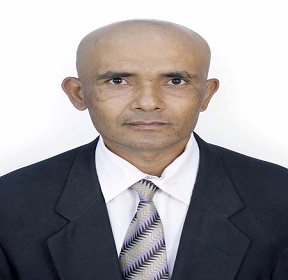Keynote Forum
Malik Wajid Hussain Chan
University of Karachi PakistanTitle: Evaluation of Heavy Metal Pollutants in Salt and Seawater under the Influence of the Lyari River and Potential Health Risk Assessment
Abstract:
Heavy metals intoxication through edible salt poses serious health hazards. The conducted research assessed the levels of heavy metals, health risks of salt samples, and the pollution index of seawater obtained from saltpans located at Sandpit, Karachi, Pakistan, which receive untreated effluents through the Lyari River. Seawater (n =27) and salt samples (n = 27) were prepared for the detection of Al, Cd, Pb, Cr, Fe, Cu, Hg, Ni, As and Zn through atomic absorption spectroscopy, mean concentrations ± S.D (mg/mL) were compared with the National Environmental Quality Standards, Pakistan. The levels of Cr (40.06 ± 0.21) were the highest followed by Fe (39.77 ± 0.08) >As (25.12 ± 0.21) >Ni>Pb>Al>Hg>Zn>Cd>Cu. In sea salt (Mean ± S.D mg/Kg), the Cr (47.79 ± 0.19), Fe (47.5 ± 0.15), As (30.62 ± 0.22), and Ni were redundant elements followed by Al>Pb>Hg>Zn>Cu>Cd. The water comprehensive pollution index was 1000 times greater than the critical values. The single factor pollution index was highest for Hg (1321), followed by Cr (40), Ni (36), Pb (32), Al (31.4), Cd (31.3), and As (25). Health risk assessment indices (from salt samples), including target hazard quotient (THQ) for As, Pb, Al, Hg, and Cr were two to six times higher than the noncarcinogenic THQ reference range. Similarly, the hazardous index indicated that salt was 20 times hazardous (HI = 20.29), and the carcinogenic rate index for the heavy metals i.e., Cd, As, Cr, and Ni was above the reference CR value i.e., 1 × 10-4. In conclusion, the experimental and theoretical approaches recommend that the use of contaminated salt may impart health hazards.
Biography:
Dr. Malik Wajid H. Chan has recently (March, 2021), completed his Ph.D from the Centre of Excellence in Marine Biology University of Karachi, Pakistan. He has published 6 articles, in international Esteemed journals. The four (out of six) have been published on the pollution stress and its effects on the local local community and fauna and flora. Some publications are in process. He has done a work on mangroves and oyster conservations in Pakistan. Dr. Chan is working on the effects of pollution stress on the metabolic rate and the biochemistry of the biota.
Yanfang Liu
Peking University Cancer Hospital & Institute ChinaTitle: METTL14 and its oncogenic roles in breast cancer cells.
Abstract:
As an important m6A dynamic modification-related protein, METTL14 was reported not only played an oncogenic role but also functioned as a tumor suppressor gene. However, regulation of METTL14 across mRNA and copy number variation (CNV) remain elusive and its role in breast cancer cells has not been clarified clearly. Analysis of TCGA and cell experiments.There is a strong positive correlation between METTL14 mRNA and CNV among all subtypes of breast cancer, which indicated a regulation between METTL14 mRNA and CNV. In addition, we found that knocking down METTL14 in breast cancer cells resulted in inhibition of cell growth and increased apoptosis in breast cancer cells.METTL14 expressed differently in various subtypes of breast and there is a possible regulation existed between mRNA and CNV. (2) METTL14 knockdown lead to slower cell growth and increased cell apoptosis.
Biography:
Yanfang Liu is studying for a PhD degree in Peking University. She has published more than 5 papers in reputed journals and was often invited to participate in paper review.
Hissa Mohammed
University of Aberdeen, UK. United KingdomTitle: The importance of making friendly environment by radiographer during radiology procedure for Oncology Pediatric patient aged between 7 – 10 years old in purpose of reduction radiation dose to the patient.
Abstract:
Radiological imaging is a diagnostic tool which is significantly valuable in the oncology pediatric population. However, there are number of contrast challenges in pediatric imaging in comparison with the imaging of adults. It is important for the radiographer to maintain a friendly environment for the pediatric population as this population are more irritable and afraid of strangers as well as unfamiliar environments. By creating a friendly environment and communicate radiographer can encourage them that improve the patient experience. To attain this the environment should be made more child-friendly, like painting the walls with colorful characters, or by keeping a small aquarium and cartoon channel in the waiting room. Another reason that radiographer need to gain the trust of pediatric population and co-operation prior and during the radiology examination, as it might be difficult in few cases where the children can be critically ill. The radiographer also needs to maintain a safe environment as the expanded radiation affectability of developing organs and pediatric population's long-anticipated life ranges make them more vulnerable to the destructive impacts of radiation. Protection and safeguarding from radiation are crucial concerns for this age group as the risk component for induction of cancer in pediatric population is a10 times higher than in adults.
Biography:
Hissa Mohammed is instructor of Medical Radiography. Prior that, she was radiology Supervisor in HMC from 2017 to December 2020. In addition, she has 8 years’ work experience as radiology technologist. Her educational background includes Master of Science in Medical Imaging from University of Aberdeen, UK. She has bachelor in Diagnostic Radiography from Queen Margaret University in UK, and Diploma in Medical Radiography from College of the North Atlantic – Qatar.



